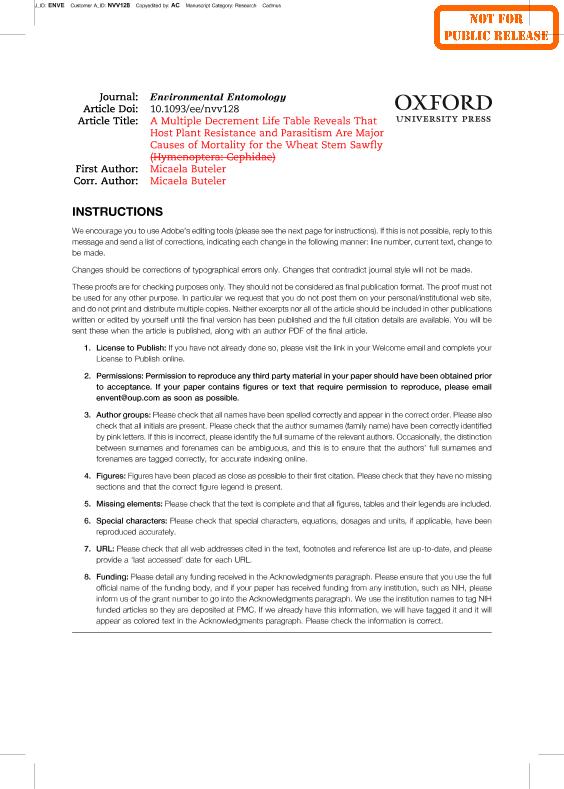Mostrar el registro sencillo del ítem
dc.contributor.author
Buteler, Micaela

dc.contributor.author
Peterson, Robert K.
dc.contributor.author
Hofland, Megan L.
dc.contributor.author
Weaver, David K.
dc.date.available
2017-01-26T15:32:29Z
dc.date.issued
2015-08
dc.identifier.citation
Buteler, Micaela; Peterson, Robert K.; Hofland, Megan L.; Weaver, David K.; A Multiple Decrement Life Table Reveals That Host Plant Resistance and Parasitism Are Major Causes of Mortality for the Wheat Stem Sawfly; Entomological Society Of America; Environmental Entomology; 44; 6; 8-2015; 1093-1099
dc.identifier.issn
0046-225X
dc.identifier.uri
http://hdl.handle.net/11336/11982
dc.description.abstract
This study investigated the dynamics of parasitism, host plant resistance, pathogens, and predation on the demography of wheat stem sawfly, Cephus cinctus Norton (Hymenoptera: Cephidae), developing in susceptible (hollow stem) and resistant (solid stem) wheat hosts. This study is also the first to investigate the prevalence and impact of cannibalism on wheat stem sawfly mortality. Wheat stem sawflies were sampled in two commercial wheat fields over 4 yr from the egg stage through adult emergence, and multiple decrement life tables were constructed and analyzed. Cannibalism, host plant resistance, or unknown factors were the most prevalent factors causing egg mortality. Summer mortality of prediapause larvae ranged from 28 to 84%, mainly due to parasitism by Bracon cephi (Gahan) and Bracon lissogaster Muesebeck, cannibalism, and host plant resistance. Winter mortality ranged from 6 to 54% of the overwintering larvae, mainly due to unknown factors or pathogens. Cannibalism is a major cause of irreplaceable mortality because it is absolute, with only a single survivor in every multiple infested stem. Subsequent to obligate cannibalism, mortality of feeding larvae due to host plant resistance was lower in hollow stem wheat than in solid stem wheat. Mortality from host plant resistance was largely irreplaceable. Irreplaceable mortality due to parasitoids was greater in hollow stem wheat than in solid stem wheat. Host plant resistance due to stem solidness and parasitism in hollow stems cause substantial mortality in populations of actively feeding larvae responsible for all crop losses. Therefore, enhancing these mortality factors is vital to effective integrated pest management of wheat stem sawfly.
dc.format
application/pdf
dc.language.iso
eng
dc.publisher
Entomological Society Of America

dc.rights
info:eu-repo/semantics/openAccess
dc.rights.uri
https://creativecommons.org/licenses/by-nc-sa/2.5/ar/
dc.subject
Multiple Decrement Life Table
dc.subject
Dynamics Parasitoid
dc.subject
Mortality Risk
dc.subject
Mortality Wheat Stem Sawfly
dc.subject.classification
Zoología, Ornitología, Entomología, Etología

dc.subject.classification
Ciencias Biológicas

dc.subject.classification
CIENCIAS NATURALES Y EXACTAS

dc.title
A Multiple Decrement Life Table Reveals That Host Plant Resistance and Parasitism Are Major Causes of Mortality for the Wheat Stem Sawfly
dc.type
info:eu-repo/semantics/article
dc.type
info:ar-repo/semantics/artículo
dc.type
info:eu-repo/semantics/publishedVersion
dc.date.updated
2016-12-12T14:22:14Z
dc.journal.volume
44
dc.journal.number
6
dc.journal.pagination
1093-1099
dc.journal.pais
Estados Unidos

dc.journal.ciudad
Lanham
dc.description.fil
Fil: Buteler, Micaela. Consejo Nacional de Investigaciones Científicas y Técnicas. Centro Científico Tecnológico Patagonia Norte. Instituto de Investigación En Biodiversidad y Medioambiente; Argentina. State University Of Montana; Estados Unidos
dc.description.fil
Fil: Peterson, Robert K.. State University Of Montana; Estados Unidos
dc.description.fil
Fil: Hofland, Megan L.. State University Of Montana; Estados Unidos
dc.description.fil
Fil: Weaver, David K.. State University Of Montana; Estados Unidos
dc.journal.title
Environmental Entomology

dc.relation.alternativeid
info:eu-repo/semantics/altIdentifier/url/http://www.bioone.org/doi/abs/10.1093/ee/nvv128
Archivos asociados
